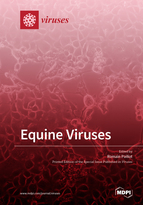Equine Viruses
A special issue of Viruses (ISSN 1999-4915). This special issue belongs to the section "Animal Viruses".
Deadline for manuscript submissions: closed (30 September 2019) | Viewed by 71606
Special Issue Editor
2. BIOTARGEN EA 7450, Normandie Université, 14280 Saint Contest, France
Interests: equine infectious diseases; immunology; vaccination; equine influenza
Special Issues, Collections and Topics in MDPI journals
Special Issue Information
Dear Colleagues,
The Food and Agriculture Organization of the United Nations has recently estimated that the world equid population exceeds 110 million (FAOSTAT 2017). Working equids (horses, ponies, donkeys, and mules) remain essential to ensure the livelihood of poor communities around the world. In many developed countries, the equine industry has a significant economical weight, with around 7 million horses in Europe alone. The close relationship between humans and equids and the fact that the athlete horse is the terrestrial mammal that travels the most worldwide after humans are important elements to consider in the transmission of pathogens and diseases, amongst equids and to other species. The potential effect of climate change on vector ecology and vector-borne diseases is also of concern for both human and animal health.
With this Special Issue, we intend to explore our understanding of equine viruses, their pathogenicity, their importance in terms of welfare, their economic importance, and how their identification can be helped by new technologies. Beyond their potential risk to other species, including humans, equine viruses may also represent an interesting model for reproducing virus infection in the host species.
Dr. Romain Paillot
Guest Editor
Manuscript Submission Information
Manuscripts should be submitted online at www.mdpi.com by registering and logging in to this website. Once you are registered, click here to go to the submission form. Manuscripts can be submitted until the deadline. All submissions that pass pre-check are peer-reviewed. Accepted papers will be published continuously in the journal (as soon as accepted) and will be listed together on the special issue website. Research articles, review articles as well as short communications are invited. For planned papers, a title and short abstract (about 100 words) can be sent to the Editorial Office for announcement on this website.
Submitted manuscripts should not have been published previously, nor be under consideration for publication elsewhere (except conference proceedings papers). All manuscripts are thoroughly refereed through a single-blind peer-review process. A guide for authors and other relevant information for submission of manuscripts is available on the Instructions for Authors page. Viruses is an international peer-reviewed open access monthly journal published by MDPI.
Please visit the Instructions for Authors page before submitting a manuscript. The Article Processing Charge (APC) for publication in this open access journal is 2600 CHF (Swiss Francs). Submitted papers should be well formatted and use good English. Authors may use MDPI's English editing service prior to publication or during author revisions.
Keywords
- virus
- vaccine
- equine
- pathogenicity
- emergence
- model
- identification







